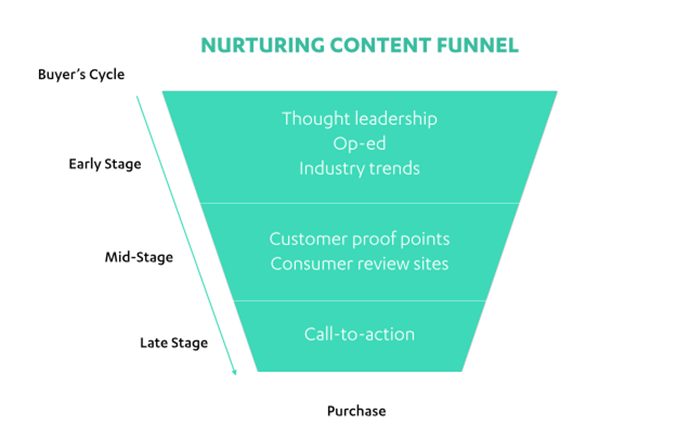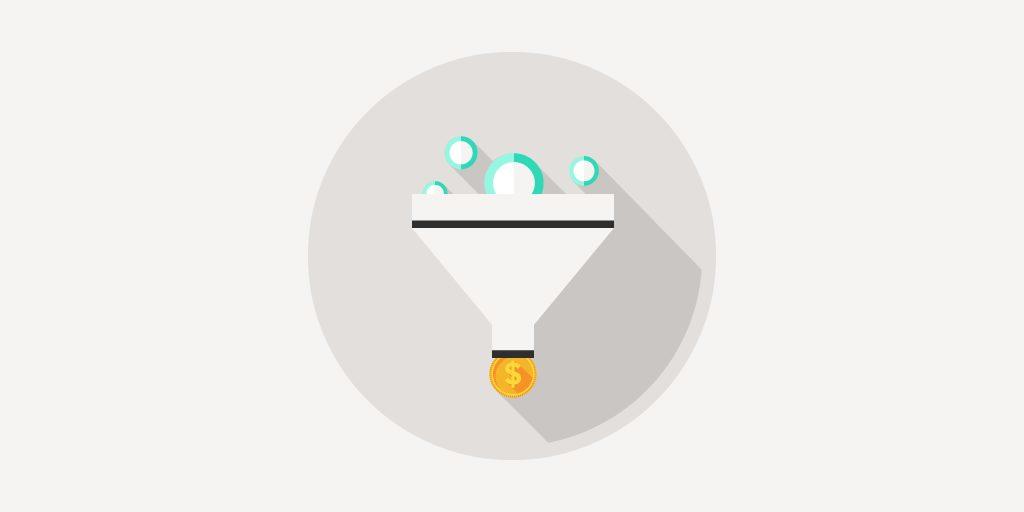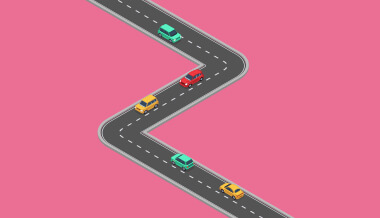August 13, 2015
Lead Nurturing Content
At its core, lead nurturing is about building enough trust where a potential customer is willing to pull out their wallet and buy from you. This concept is based on the fact that every new person who subscribes to your blog, fills out a contact form, or downloads a whitepaper isn’t ready to buy yet. Some are, and that’s great, but most people need to find out…
- If you know what you’re talking about by engaging with your content
- If others have had success with your products and services by reading your customer stories or online reviews
- If you have the resources to provide the results they want
- If what you offer is a good fit for them before they are ready to buy
In other words, the relationship with prospective buyers needs to be nurtured. In this post, you will learn the three stages of the nurturing content funnel, the power of “accelerators,” the necessity of “decelerators”, and pro tips we’ve learned from years of dissecting, innovating, and experimenting with lead nurturing.
Say hello to The Nurturing Content Funnel…
There are three different stages in the buying cycle, each with its own unique conversation happening in the potential customer’s mind:
- Early stage: “I’m just doing research and not even close to making a purchase yet”
- Mid-stage: “I’m interested in buying, but want more information to see if DogToday is the best choice for me”
- Late stage: “Okay, I think I’m ready to buy”
Do you see how different types of content would be helpful and relevant depending on what stage your leads are in? That’s where The Nurturing Content Funnel comes into play.  The trick is to match the type of content you send to leads based on their stage in the buying cycle. What follows is a breakdown of each stage of the nurturing content funnel. Bonus points: Use marketing automation software to put the whole thing on Autopilot.
The trick is to match the type of content you send to leads based on their stage in the buying cycle. What follows is a breakdown of each stage of the nurturing content funnel. Bonus points: Use marketing automation software to put the whole thing on Autopilot.
Early stage - “I’m just doing research”
 Potential buyers at this stage are low-commitment. They haven’t bought from you yet, engaged with your sales team, or clicked on any of your more product-focused content. The way to nudge them to the next stage is to speak to their needs and interests with non-salesy, helpful content. Specifically, that means:
Potential buyers at this stage are low-commitment. They haven’t bought from you yet, engaged with your sales team, or clicked on any of your more product-focused content. The way to nudge them to the next stage is to speak to their needs and interests with non-salesy, helpful content. Specifically, that means:
- Best practices: Share your treasure chest of insights from doing what you do. What’s normal to you could be mind-blowing to others.
- Tips and tactics: Get into the nuts and bolts of teaching your customers what they want to learn from you. Step-by-step content is proven to draw people in.
- Industry trends and commentary: Put a stake in the ground about your thoughts on an issue. Articulate your perspective with confidence and share your view of the world.
- Thought leadership: Bring innovative ideas and leadership into your area of expertise. What’s the next big thing in your space? What have you learned that no one’s shared publicly yet?
The rule of thumb we recommend, especially for early-stage content, is to shoot for 95% teaching and 5% selling. This keeps you top of mind so leads will come knockin’ when they are ready to buy.  Timing: The best frequency to send depends on the length of your sales cycle, but a simple starting point is to send a series of three to five emails, spaced 10 days apart, using your top-performing content. Then experiment with different sending frequencies from there. The logic behind this is you want send communications at least every 2-4 weeks to generate 2x the leads without making a dent in unsubscribe rates. Once leads open up and click through your early-stage content, you “accelerate” them to the next stage.
Timing: The best frequency to send depends on the length of your sales cycle, but a simple starting point is to send a series of three to five emails, spaced 10 days apart, using your top-performing content. Then experiment with different sending frequencies from there. The logic behind this is you want send communications at least every 2-4 weeks to generate 2x the leads without making a dent in unsubscribe rates. Once leads open up and click through your early-stage content, you “accelerate” them to the next stage.
Wait, what does “accelerate” mean?
 “Accelerate” means to move a lead to the mid-stage of the funnel after they engage with your early-stage content. We’ve coined the middle of the funnel as the “Accelerator” track because you send emails at a shorter frequency.
“Accelerate” means to move a lead to the mid-stage of the funnel after they engage with your early-stage content. We’ve coined the middle of the funnel as the “Accelerator” track because you send emails at a shorter frequency.
Mid-stage - “I’m interested in buying, but want more information”
 Potential buyers at this stage are becoming more open to buying from you. They’ve read your content, know that you know what you’re talking about, and are curious to learn more and/or see how others have had success buying from you. The best content to speak to them at this stage is a combination of…
Potential buyers at this stage are becoming more open to buying from you. They’ve read your content, know that you know what you’re talking about, and are curious to learn more and/or see how others have had success buying from you. The best content to speak to them at this stage is a combination of…
- More in-depth content closely related to the early-stage content, like sending a 30-minute video or webinar replay that expands on the 5-page ebook you sent before.
- Relatable customer stories showing the results other people have had success from working with you.
- Consumer reviews, like Yelp reviews for brick and mortar spots or G2Crowd for software products.
Timing: These emails are more frequent, typically spaced two to three days apart. The logic behind this is that because a lead engaged with your previous content, you are fresh on their mind. There is a higher probability they are imagining themselves as a customer or at the very least, open to it. Waiting ten days to send a customer case study may miss your window of opportunity to accelerate them to the next stage, a “call-to-action” flow.
Late-stage - “Okay, I think I’m ready to buy”
 Potential buyers at this stage are now warm leads that are ready to be passed off to sales. Enough trust has been built where they are willing to take the next step and buy from you. All you have to do is make the invitation with…
Potential buyers at this stage are now warm leads that are ready to be passed off to sales. Enough trust has been built where they are willing to take the next step and buy from you. All you have to do is make the invitation with…
- A targeted promotional offer based on the content they’ve been reading, like a wine company offering a red wine promotion after sending a red wine ebook and video
- A call-to-action to demo or sign up for a free trial of your product
- A personalized, text-based email to “hop on a call” or “join a working session” to close the deal over the phone
Timing: They are usually spaced two to three days after a mid-stage email, to make the call-to-action while the lead is still hot. What if contacts don’t engage with mid or late-stage content?  In the scenario where readers don’t engage with your “accelerator” track or call-to-action content, assume the reader is less qualified and decelerate them back “up” to the early-stage nurturing track. This in turn spares your reader from annoying or pushy sales request emails, and saves you from losing valuable contacts who are more likely to unsubscribe.
In the scenario where readers don’t engage with your “accelerator” track or call-to-action content, assume the reader is less qualified and decelerate them back “up” to the early-stage nurturing track. This in turn spares your reader from annoying or pushy sales request emails, and saves you from losing valuable contacts who are more likely to unsubscribe.
The lead nurturing continues…
To recap, the lead nurturing content funnel helps you to connect with leads with just-the-right-messages in each stage of the buying cycle. By putting the above strategies into action, the journey from lead to sale will feel more natural, you’ll convert more leads, and you’ll be guiding your customer with empathy every step of the way. Are you hungry for more lead nurturing articles? Learn our secrets or listen in on the experts. Or if you are ready to try lead nurturing yourself, take Autopilot for a test flight.













